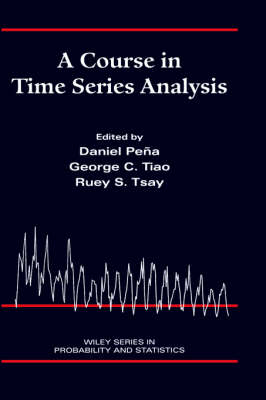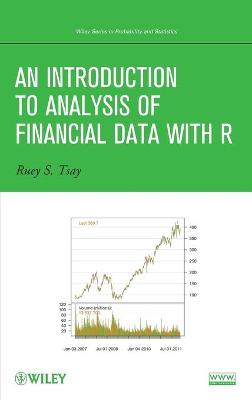Wiley Series in Probability and Statistics
2 primary works • 6 total works
Book 322
A Course in Time Series Analysis
by Daniel Pena, George C. Tiao, and Ruey S. Tsay
Special features include: * Contributions from eleven of the worlda s leading figures in time series * Shared balance between theory and application * Exercise series sets * Many real data examples * Consistent style and clear, common notation in all contributions *60 helpful graphs and tables Requiring no previous knowledge of the subject, A Course in Time Series Analysis is an important reference and a highly useful resource for researchers and practitioners in statistics, economics, business, engineering, and environmental analysis. An Instructor's Manual presenting detailed solutions to all the problems in the book is available upon request from the Wiley editorial department.
Book 485
Subsequent chapters explore basic time series analysis and simple econometric models for business, finance, and economics as well as related topics including: * Linear time series analysis, with coverage of exponential smoothing for forecasting and methods for model comparison * Different approaches to calculating asset volatility and various volatility models * High-frequency financial data and simple models for price changes, trading intensity, and realized volatility * Quantitative methods for risk management, including value at risk and conditional value at risk * Econometric and statistical methods for risk assessment based on extreme value theory and quantile regression Throughout the book, the visual nature of the topic is showcased through graphical representations in R, and two detailed case studies demonstrate the relevance of statistics in finance. A related website features additional data sets and R scripts so readers can create their own simulations and test their comprehension of the presented techniques.
An Introduction to Analysis of Financial Data with R is an excellent book for introductory courses on time series and business statistics at the upper-undergraduate and graduate level. The book is also an excellent resource for researchers and practitioners in the fields of business, finance, and economics who would like to enhance their understanding of financial data and today's financial markets.
A comprehensive resource that draws a balance between theory and applications of nonlinear time series analysis
Nonlinear Time Series Analysis offers an important guide to both parametric and nonparametric methods, nonlinear state-space models, and Bayesian as well as classical approaches to nonlinear time series analysis. The authors-noted experts in the field-explore the advantages and limitations of the nonlinear models and methods and review the improvements upon linear time series models.
The need for this book is based on the recent developments in nonlinear time series analysis, statistical learning, dynamic systems and advanced computational methods. Parametric and nonparametric methods and nonlinear and non-Gaussian state space models provide a much wider range of tools for time series analysis. In addition, advances in computing and data collection have made available large data sets and high-frequency data. These new data make it not only feasible, but also necessary to take into consideration the nonlinearity embedded in most real-world time series. This vital guide:
* Offers research developed by leading scholars of time series analysis
* Presents R commands making it possible to reproduce all the analyses included in the text
* Contains real-world examples throughout the book
* Recommends exercises to test understanding of material presented
* Includes an instructor solutions manual and companion website
Written for students, researchers, and practitioners who are interested in exploring nonlinearity in time series, Nonlinear Time Series Analysis offers a comprehensive text that explores the advantages and limitations of the nonlinear models and methods and demonstrates the improvements upon linear time series models.
Master advanced topics in the analysis of large, dynamically dependent datasets with this insightful resource
Statistical Learning with Big Dependent Data delivers a comprehensive presentation of the statistical and machine learning methods useful for analyzing and forecasting large and dynamically dependent data sets. The book presents automatic procedures for modelling and forecasting large sets of time series data. Beginning with some visualization tools, the book discusses procedures and methods for finding outliers, clusters, and other types of heterogeneity in big dependent data. It then introduces various dimension reduction methods, including regularization and factor models such as regularized Lasso in the presence of dynamical dependence and dynamic factor models. The book also covers other forecasting procedures, including index models, partial least squares, boosting, and now-casting. It further presents machine-learning methods, including neural network, deep learning, classification and regression trees and random forests. Finally, procedures for modelling and forecasting spatio-temporal dependent data are also presented.
Throughout the book, the advantages and disadvantages of the methods discussed are given. The book uses real-world examples to demonstrate applications, including use of many R packages. Finally, an R package associated with the book is available to assist readers in reproducing the analyses of examples and to facilitate real applications.
Analysis of Big Dependent Data includes a wide variety of topics for modeling and understanding big dependent data, like:
- New ways to plot large sets of time series
- An automatic procedure to build univariate ARMA models for individual components of a large data set
- Powerful outlier detection procedures for large sets of related time series
- New methods for finding the number of clusters of time series and discrimination methods , including vector support machines, for time series
- Broad coverage of dynamic factor models including new representations and estimation methods for generalized dynamic factor models
- Discussion on the usefulness of lasso with time series and an evaluation of several machine learning procedure for forecasting large sets of time series
- Forecasting large sets of time series with exogenous variables, including discussions of index models, partial least squares, and boosting.
- Introduction of modern procedures for modeling and forecasting spatio-temporal data
Perfect for PhD students and researchers in business, economics, engineering, and science: Statistical Learning with Big Dependent Data also belongs to the bookshelves of practitioners in these fields who hope to improve their understanding of statistical and machine learning methods for analyzing and forecasting big dependent data.
Featuring the techniques and methodology of multivariate linear time series, stationary VAR models, VAR MA time series and models, unitroot process, factor models, and factor-augmented VAR models, the book includes: Over 300 examples and exercises to reinforce the presented content User-friendly R subroutines and research presented throughout to demonstrate modern applications Numerous datasets and subroutines to provide readers with a deeper understanding of the material Multivariate Time Series Analysis is an ideal textbook for graduate-level courses on time series and quantitative finance and upper-undergraduate level statistics courses in time series. The book is also an indispensable reference for researchers and practitioners in business, finance, and econometrics.



